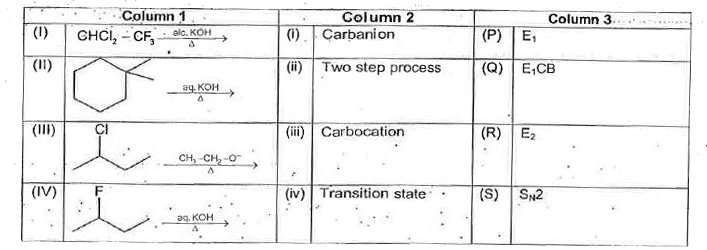The Calvin cycle proceed in three stages:
1. Radiation, during which carbohydrate is formed at the expense of the Photochemically made ATP and NADPH.
2. Regeneration, during which the carbon dioxide acceptor ribulose-1,5-biphate is formed.
3. Carboxylation, during which the carbon dioxide combines with ribulose-1,5-biphosphate.
Identify the correct sequence.
3→1→2
3→2→1
1→2→3
2→1→3
The correct Answer is:A
To identify the correct sequence of the Calvin cycle stages, we need to analyze the three stages mentioned in the question: Carboxylation, Reduction (often referred to as Radiation in the question), and Regeneration. Here’s the step-by-step solution:
Step 1: Understand the Stages of the Calvin Cycle
1. Carboxylation: This is the first stage where carbon dioxide (CO2) is fixed. In this process, CO2 combines with ribulose-1,5-bisphosphate (RUBP) to form a stable intermediate, which is 3-phosphoglycerate (3-PGA). The enzyme Rubisco catalyzes this reaction.
2. Reduction (Radiation): In this stage, 3-PGA is converted into glyceraldehyde-3-phosphate (G3P) using ATP and NADPH produced during the light-dependent reactions of photosynthesis. This is where carbohydrates are formed.
3. Regeneration: The final stage involves the regeneration of RUBP from G3P, allowing the cycle to continue. This process requires ATP.
Step 2: Sequence the Stages
Based on the understanding of each stage:
- First Stage: Carboxylation (CO2 combines with RUBP)
- Second Stage: Reduction (Formation of carbohydrates)
- Third Stage: Regeneration (RUBP is regenerated)
Conclusion: Correct Sequence
Thus, the correct sequence of the Calvin cycle is:
1. Carboxylation
2. Reduction (Radiation)
3. Regeneration
The answer to the question is that the correct option is the first one, which corresponds to the sequence: Carboxylation → Reduction → Regeneration.
1. Carboxylation: This is the first stage where carbon dioxide (CO2) is fixed. In this process, CO2 combines with ribulose-1,5-bisphosphate (RUBP) to form a stable intermediate, which is 3-phosphoglycerate (3-PGA). The enzyme Rubisco catalyzes this reaction.
2. Reduction (Radiation): In this stage, 3-PGA is converted into glyceraldehyde-3-phosphate (G3P) using ATP and NADPH produced during the light-dependent reactions of photosynthesis. This is where carbohydrates are formed.
Based on the understanding of each stage:
- First Stage: Carboxylation (CO2 combines with RUBP)
- Second Stage: Reduction (Formation of carbohydrates)
- Third Stage: Regeneration (RUBP is regenerated)
Thus, the correct sequence of the Calvin cycle is:
1. Carboxylation
2. Reduction (Radiation)
3. Regeneration
Topper's Solved these Questions
Similar Questions
Assertion: Photochemical smog is oxidising in nature.
Reason: Photochemical smog contains NO2 and O3 which are formed during the sequence of reactions.
View SolutionGiven below are four jumbled sentences. Select the option that gives their correct order.S1: Plants need carbon for building the tissue of their bodies.
S6: Thus through a complex process called photosynthesis, plants receive their requirements from the soil and Sun
P: The breaking up of carbon dioxide into its components requires energy, which they derive from the Bun
Q: Plants other needs of nutrients are derived from the sail and water through their roots.
R: They derive this carbon from the carbon dioxide in the air.
S: They break up the carbon dioxide, absorb the carbon and discharge oxygen into the air for animals to breatha The proper sequence should be
View Solution
Knowledge Check
The Calvin cycle proceeds in three stages
(1) Reduction, during which carbohydrate is formed at the expense of the photochemically made ATP and NADPH
(2) Regeneration, during which the carbon dioxide acceptor ribulose-1,5-biphosphate is formed
(3) Carboxylation during which carbon dioxide combines with ribulose-1,5-biphoshate is formedA3−1−2B3−2C1−2−3D2−1−31, 2, and 3 by appropriately matching the information given in the three columns of the following table.

The only CORRECT combination in which the reaction proceeds through radical mechanism is:A[A](I)(iii)(R)B[B] (II) (iii) (Q)C[C] (III) (ii) (P)D[D](IV)(i)(R)Which of the following is the only 5-carbon compound formed during Krebs cycle
AMalic acidBSuccinic acidCcis-aconitic acidDα-ketoglutaric acid.
The number of 5 digit numbers which can be formed using the digits 0,1,2,3,5 which are divisible by 25 are
View SolutionIf 1 moles of ethanol (C2H5OH) completely burns to form carbon dioxide formed is about
View SolutionAssertion: Photochemical smog is oxidising in nature.
Reason: Photochemical smog contains NO2 and O3 which are formed during the sequence of reactions.
View SolutionWhich of the following is the only 5-carbon compound formed during Krebs cycle
View SolutionAssertion: Photochemical smog is oxidising in nature.
Reason: Photochemical smog contains NO2 and O3 which are formed during the sequence of reactions.
View Solution
